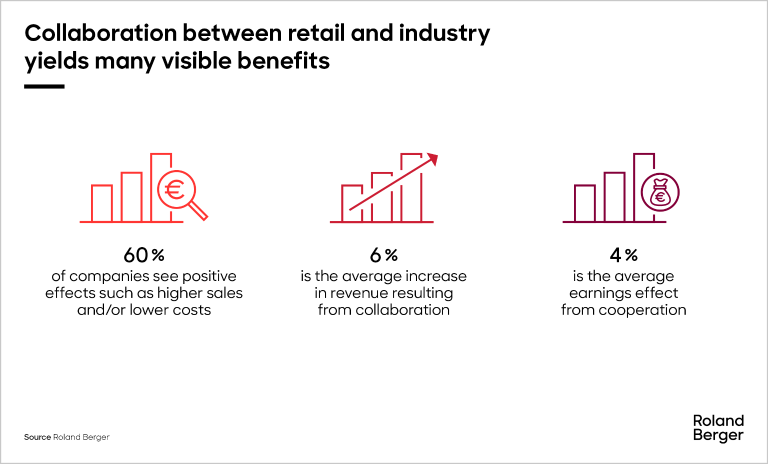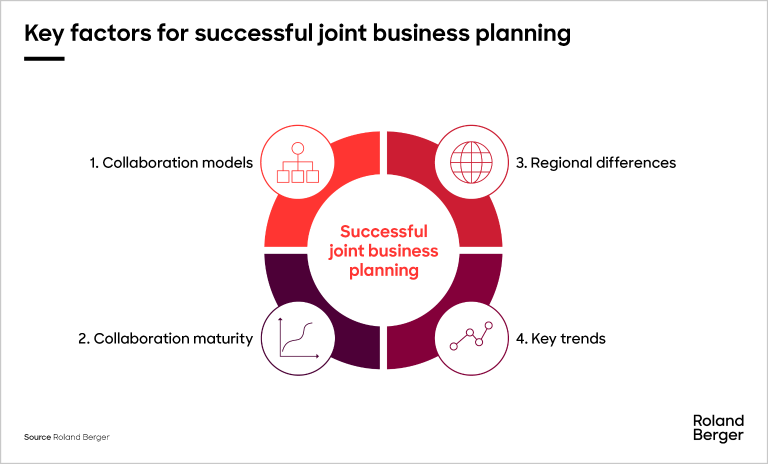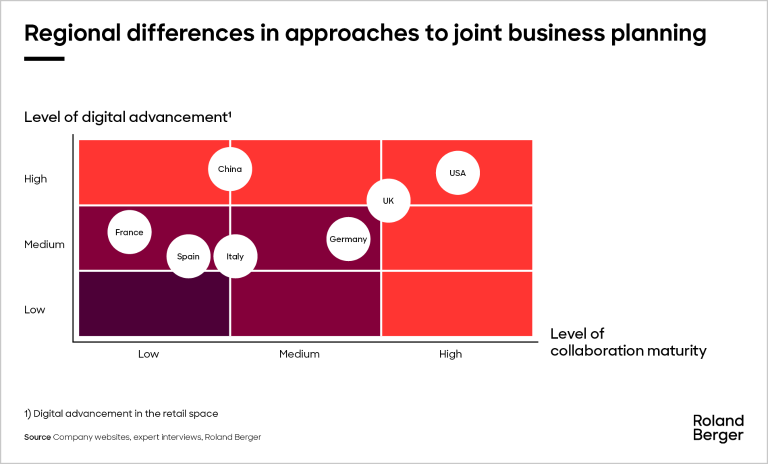How retail can protect its future


Call for collaboration
Why joint business planning is vital to growth and how best practices make it work
Retailers and the manufacturers whose products they sell instinctively know it makes sense to work together and not against each other. Why, then, does collaboration consistently prove to be so difficult? As macroeconomic factors put enormous pressure on every kind of supplier relationship, the temptation is for either side to try to do everything itself. However, the need for efficiency and impact makes one thing abundantly clear: Collaboration is more crucial today than it has ever been.

This article addresses the “why” and the “how” questions: Why is it critical for brand manufacturers and retailers to align their approaches and work together to drive mutual success? After briefly outlining current macroeconomic challenges, we delve into key benchmarking results, showcasing different models for collaboration, explaining varying levels of maturity and addressing regional differences. We also discuss the impact of trends that are shaping consumer markets today. Shifting to a hands-on focus on delivering success, we then explore best practices – and potential pitfalls – to help businesses successfully navigate the complexities of joint business planning.
Macroeconomic challenges
High inflation has significantly increased the cost of raw materials, labor, transportation and other factors, squeezing profit margins and putting pressure on retailers and manufacturers alike. This pressure is made worse when customers are unwilling or simply unable to swallow price increases, causing sales and profits to tremble. The food industry is only one sector where disputes over pricing have thus flared up between retailers and brands, with both sides preferring to “go it alone” rather than pulling together. In many cases, existing relationships have suffered and opportunities to jointly add value have been missed.
The rationale behind collaboration
Instead of turning inward and trying to solve macroeconomic problems on their own, market players would do better to collaborate with partners and engage in joint business development. What is more, a recent Roland Berger survey shows that most stakeholders already know this! As the figure below shows, both sides understand that working together lets them leverage each other’s strengths, realize synergies and share greater success.
In a worldwide benchmarking study, Roland Berger recently evaluated the most effective joint business planning practices in the consumer goods and retail ecosystem. Our findings revealed what works and what doesn’t – the best practices and pitfalls that are described below. The principles discussed can be applied to supplier/client relationships in various industries, but are of tremendous importance to retailers and brand manufacturers.
Four key factors that influence the success of joint business planning
Our study identified four key factors that are instrumental in determining the collaboration between retailers and manufacturers.
"Data is key to digital transformation. Sharing data and generating relevant insights to win with shoppers is key to effective JBP collaboration."
1. Collaboration models
The models adopted should reflect the partner’s importance to the other party, their potential, their willingness to collaborate and/or their strategic fit. The organizational structure should then be aligned with this model. A “basic” collaboration model may be sufficient for low-level cooperation – focusing on annual transaction negotiations with secondary partners whose potential and willingness to collaborate is limited. Conversely, an “advanced” model embracing cross-functional elements would be better suited to a more important partner. Both parties would expect to invest more resources in this kind of collaboration, which could involve setting up strategic joint projects. Longer timeframes and top management commitment are strongly advisable for advanced projects.
In practice, most forms of collaboration will be somewhere between these two extremes and will therefore take on a multifunctional nature. For example, collaboration could be built around a specific function such as marketing or IT.
2. Collaboration maturity
The more mature the collaboration between partners, the more trust the partners will develop over time. A firm foundation of trust in turn encourages the partners to widen the scope of collaboration across more departments or functions, extend the timelines for cooperation, accept greater risks and share the resultant gains. The kind of open or cross-functional models described above are thus a clear sign of mature levels of collaboration. Comparatively immature constellations will initially restrict themselves to more basic collaborative topics.
3. Regional differences
Our benchmark study found clear variations in the joint business planning practices adopted in different countries and regions. These differences center in particular around the level of digital advancement and, hence, how companies collaboratively harness data to add value. On the other hand, it is important to align collaborative approaches with any such regional differences and adopt the appropriate regional best practices to the according data use and collaboration maturity.
4. Key industry trends
Major trends affecting the consumer goods and retail industry as a whole also influence collaboration between players in this industry. Our study shows that four such trends are currently having the most powerful effect on brand-retailer collaboration:
- Inflation and cost pressure
For the reasons discussed under “Macroeconomic challenges,” cost pressures in the value chain and consumers’ unwillingness or inability to cope with higher prices are prompting frequent disputes between retailers and manufacturers. Rather than trying to cope with these challenges in isolation, closer and more open cooperation could help market players ease rising costs by sharing risks and optimizing synergies. Some partners are doing so, but the trend is exacting a heavy toll. - Sustainability
Stakeholder expectations are forcing companies in all industries to prioritize environment, social and governance (ESG) criteria. Brands and retailers therefore have important choices to make about how they share data and what innovative solutions they pursue to realize their own ESG ambitions and help other players meet their goals. The higher cost of sustainable materials and products, for example, often necessitates adjustments in assortments and pricing. If brands and retailers work together to share the same understanding of stakeholders, they can streamline the task of redesigning both products and processes (for example by shortening logistical paths). - Supply reliability for retailers
In the wake of a series of supply chain challenges, retailers increasingly want to work with suppliers that can satisfy their demands quickly and, above all, reliably. Since volume demand and demand for different types of products can be very volatile in the short term, it is more important than ever to collaborate closely on forecasting sales and managing inventories. - Data and technology
The increasing availability of data and technologies such as AI and automation will deliver a smoother digital experience (thanks to AI applications and RFID tags, for example), while also reducing headcounts. Leveraging data across market players will enable more accurate predictions and facilitate better decision-making. Companies that drive this change – ideally in collaboration with trusted partners – will find themselves well placed to maximize the resultant benefits.
This list of influential trends is by no means exhaustive: Many other factors clearly affect cooperation between retailers and brand manufacturers to a greater or lesser degree. Contact our experts to gain insight into all the trends.
Getting the most out of joint business planning – Best practices to adopt and pitfalls to avoid
By combining in-depth research with executive interviews and our own project experience in the consumer goods and retail industry, Roland Berger has been able to benchmark successful joint business planning approaches on a global basis. We have thus distilled best practices that support effective collaboration between retailers and manufacturers, but also identified pitfalls that must be red-flagged as joint activities develop and grow.
Alongside the above “do’s”, our study also identified a number of definite “don’ts” – practices that it is critical to avoid when seeking to nurture joint business planning. Three of the ten pitfalls we identified are outlined below:
Getting started with more robust joint business planning
The case for robust collaboration between brand manufacturers and retailers is clear and compelling. A good place to start is therefore to think carefully about – and provide honest answers to – the following questions:
- Do we feel well equipped to respond to the rapidly changing retail market landscape – locally and globally?
- When and where are we getting maximum value from our relationships with retailers?
- Are we genuinely willing to engage in joint business planning at scale? If so:
- What will be our approach to joint business planning in the coming years?
- What resources (manpower, capabilities, network, organizational set-up etc.) do we need to develop and strengthen this approach?
- Which retail partners are worth considering for joint business planning? How do we segment them (by country)?
Roland Berger would be happy to place its expertise at your disposal as you seek to implement best-practices for joint value creation. We relish the chance to join the discussion and work with you toward more successful outcomes. We look forward to hearing from you!
We would like to thank Robert Baker, Stephane Tubiana, Artem Zakomirnyi, Siobhan Gehin, Kathy Jiang, Fernando Lopez de los Mozos, Michaela Wrede and Charlotte Kasper for their contribution to this study.









